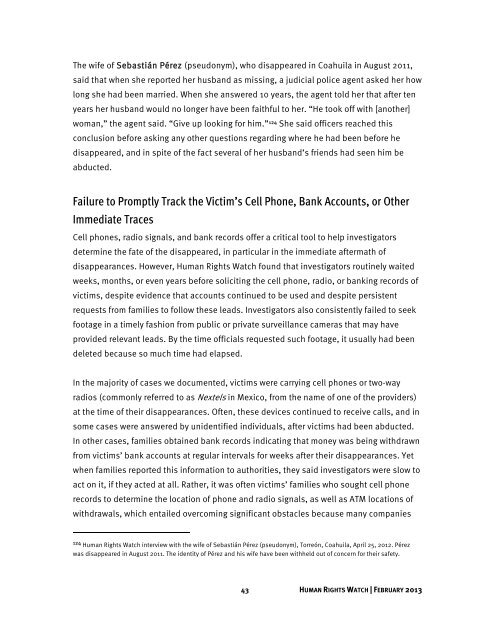Download the full report - Human Rights Watch
Download the full report - Human Rights Watch
Download the full report - Human Rights Watch
Create successful ePaper yourself
Turn your PDF publications into a flip-book with our unique Google optimized e-Paper software.
The wife of Sebastián Pérez (pseudonym), who disappeared in Coahuila in August 2011,<br />
said that when she <strong>report</strong>ed her husband as missing, a judicial police agent asked her how<br />
long she had been married. When she answered 10 years, <strong>the</strong> agent told her that after ten<br />
years her husband would no longer have been faithful to her. “He took off with [ano<strong>the</strong>r]<br />
woman,” <strong>the</strong> agent said. “Give up looking for him.” 124 She said officers reached this<br />
conclusion before asking any o<strong>the</strong>r questions regarding where he had been before he<br />
disappeared, and in spite of <strong>the</strong> fact several of her husband’s friends had seen him be<br />
abducted.<br />
Failure to Promptly Track <strong>the</strong> Victim’s Cell Phone, Bank Accounts, or O<strong>the</strong>r<br />
Immediate Traces<br />
Cell phones, radio signals, and bank records offer a critical tool to help investigators<br />
determine <strong>the</strong> fate of <strong>the</strong> disappeared, in particular in <strong>the</strong> immediate aftermath of<br />
disappearances. However, <strong>Human</strong> <strong>Rights</strong> <strong>Watch</strong> found that investigators routinely waited<br />
weeks, months, or even years before soliciting <strong>the</strong> cell phone, radio, or banking records of<br />
victims, despite evidence that accounts continued to be used and despite persistent<br />
requests from families to follow <strong>the</strong>se leads. Investigators also consistently failed to seek<br />
footage in a timely fashion from public or private surveillance cameras that may have<br />
provided relevant leads. By <strong>the</strong> time officials requested such footage, it usually had been<br />
deleted because so much time had elapsed.<br />
In <strong>the</strong> majority of cases we documented, victims were carrying cell phones or two-way<br />
radios (commonly referred to as Nextels in Mexico, from <strong>the</strong> name of one of <strong>the</strong> providers)<br />
at <strong>the</strong> time of <strong>the</strong>ir disappearances. Often, <strong>the</strong>se devices continued to receive calls, and in<br />
some cases were answered by unidentified individuals, after victims had been abducted.<br />
In o<strong>the</strong>r cases, families obtained bank records indicating that money was being withdrawn<br />
from victims’ bank accounts at regular intervals for weeks after <strong>the</strong>ir disappearances. Yet<br />
when families <strong>report</strong>ed this information to authorities, <strong>the</strong>y said investigators were slow to<br />
act on it, if <strong>the</strong>y acted at all. Ra<strong>the</strong>r, it was often victims’ families who sought cell phone<br />
records to determine <strong>the</strong> location of phone and radio signals, as well as ATM locations of<br />
withdrawals, which entailed overcoming significant obstacles because many companies<br />
124 <strong>Human</strong> <strong>Rights</strong> <strong>Watch</strong> interview with <strong>the</strong> wife of Sebastián Pérez (pseudonym), Torreón, Coahuila, April 25, 2012. Pérez<br />
was disappeared in August 2011. The identity of Pérez and his wife have been withheld out of concern for <strong>the</strong>ir safety.<br />
43 HUMAN RIGHTS WATCH | FEBRUARY 2013

















